- Review
- Technology
- Video games
This was published 5 years ago
Battlefield tactics meet military Hogwarts in Fire Emblem: Three Houses
By Tim Biggs
One half fantasy battlefield game and one half university relationship manager, Fire Emblem: Three Houses is an immaculate and captivating rabbit hole of a game, and the high point of the series' entire 30-year history.
For the uninitiated these games see you manage an army; guiding your archers, swordsmen, mages, mounted and flying units around in turn-based battles while between skirmishes you also equip them and guide their growth.
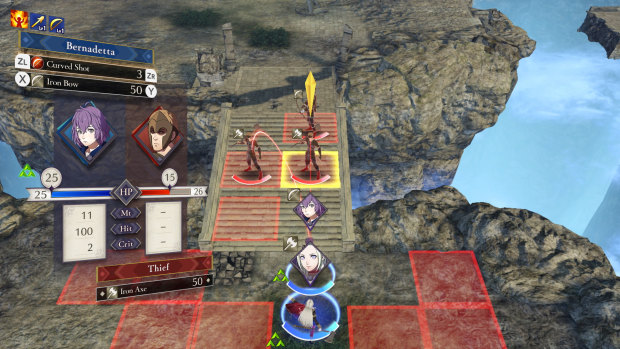
The grid-based battles have been made more readable and complex than ever in Three Houses.
The twist is that each one of those units has a name, a personality and their very own narratives — not only as part of the wider story but also in more personal stories with every other character — which are revealed as their bonds with their war buddies grow. And if you get a person killed, they're gone for good.
Three Houses is a stronger package across the board with gorgeous animated cut-scenes, a brilliantly twisting main story, a more grounded and tangible setting, and a more cinematic and action-focused presentation that doesn't compromise the slow-burn tactical goodness the game made its name on. Combat is expanded yet fairer and further refined, and the relationship-building is far more engrossing and narratively interesting.
Those who are only interested in one side of the game can automate most of the out-of-battle stuff, or set it so that dead comrades come back after each fight, but from my perspective doing either robs the game of its biggest strength; that the two halves combine to create a hugely customisable strategy experience with high and personal stakes.
You play as a male or female mercenary who, under very unusual circumstances, becomes a professor at a church-controlled military academy attended by anime-inspired and ludicrously attractive young men and women with various interests and aptitudes.
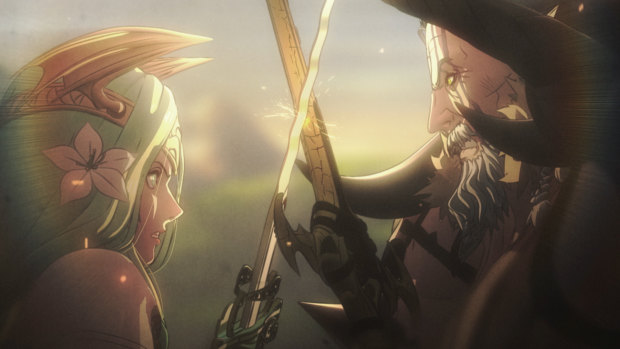
Animated cut-scenes are few and far between, but breathtaking.
They're divided into three classes, based on the regions from which they hail, and one of the first decisions you have to make is which group to take under your wing. It's not totally accurate to say you can see three different stories with three different groups of characters — because many story beats remain the same regardless and there is potential to recruit fighters from other houses — but you do get a distinct perspective from each house, and given a playthrough of just one will take at least 60 hours there's a lot of game here.
On the battlefield, this is the most active and exciting Fire Emblem yet. It's the first HD game in the series and that extra fidelity is put to good use with a camera system that lets you zoom right out to see a huge chunk of the battlefield, or right in to view your units from an action game perspective. Controlling the game up close can be a bit cumbersome, but it's awesome to see these battles at a proper scale for the first time, especially since levels vary from forests to beaches to towns to dungeons.
In previous games I often skipped the animations that show units fighting each other, but this time I kept them on throughout because they're just so slick and well done. Standard attacks, critical hits, combat abilities, dodges and counter-attacks are all fluid and quick, and the units themselves are impressively detailed.
Victory often takes a lot of planning to maximise your various units' effectiveness while keeping them safe from harm — and it's now easier to do that thanks to improved battle forecasts and clear graphics that show enemy intentions and abilities — so the brutal battle animations also serve as a point of emphasis when you manage to wipe everyone out in a single well-devised turn.
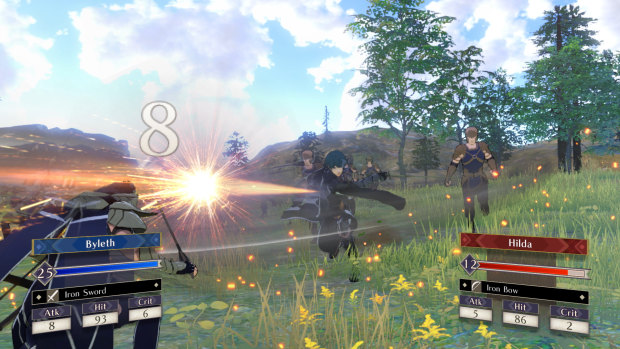
Combat exchanges are slick, fast and brutal.
Brand new this time is the gambit system, which lets you assign battalions of generic fighters for each unit to command, which bolster and support them while offering special attacks that can stall, poison or otherwise hurt multiple enemies at once. It adds a great extra wrinkle to the strategy, and when you're zoomed in or attacking you can actually see the battalions fighting away, making the levels feel more like significant battles and less like 20 overpowered individuals blasting each other.
Some time-bending business returns from the previous game, meaning you can reverse the course of events a handful of times per fight if a slip-up or random occurrence gets someone killed. This provides a great balance where you're allowed to take risks within reason with limited outs if it doesn't go your way. The system only failed me once, when my long-time healer was struck down in the final turn of a fight and I wasn't given the option to bring her back. I was devastated.
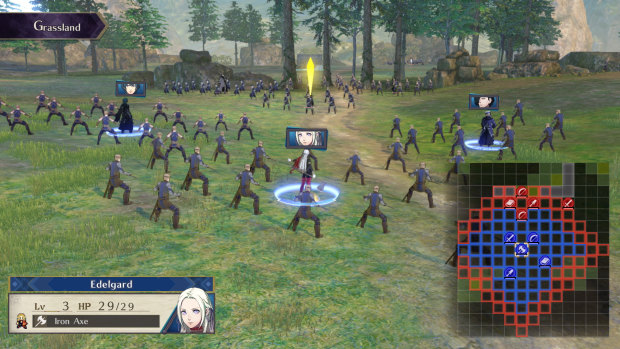
A new life-scale view lets you see the units and battlefields in full for the first time, if you like.
But fighting is only half the game. Three Houses is broken into calendar months, and at the start of each week you need to create a lesson plan for your students to determine what they'll study — from swordplay to science to horseriding to faith — and pull some aside for one-on-one tutoring.
Each student has strengths, weaknesses and latent skills that can become strengths if exercised, and growing their talents through study and battle is how you earn new abilities for your fighters and qualify them for new classes. The archer is an early class that just requires basic bow knowledge for example, while a master class like the mortal savant requires extensive sword and black magic capabilities.

Each character has a story to explore with every other character in their house, and many from other houses, so you couldn't possibly see all stories in a single play-through.
The students themselves are distinct and easy to grow attached to. They express to you their goals and problems during class, which you can respond to with advice or by adjusting their plan, and it really got me invested in their progress. Of course you can ignore them entirely and make the obvious archer into a fortress knight, it's just a lot of work and you'll need to butter them up to keep their motivation high.
Each student starts off as a groan-worthy stereotype but reveals their hidden depth of character as their various peers get to know them. You can even embark on special battles that play into the character's narrative themes, whether that's family expectations, breaking free of caste or something much more whimsical. Units grow closer by fighting nearby each other, or when you assign them group activities at the monastery. As friendships grow you'll get to watch delightful support conversations that have the characters sorting out their deep seated issues, or even just bonding over a mutual love of books, and it plays into your experience on the battlefield too.

This was shortly after Ingrid had impaled at least nine enemy soldiers with her lance from the back of a wyvern.
For example when a character had a particularly personal stake in a battle I found myself prioritising their movements, even if they weren't the strongest on the field, and I was usually rewarded with unique dialogue.
The player character can also grow closer to the students, particularly on Sundays when you're free to wander around the monastery. You can find lost items for your friends, do simple quests and activities like fishing, invite your students for a meal or even a tea party. This all makes the stakes in battle all the higher, as for example when my healer died all her stories were cut short, and I never found out her favourite tea.
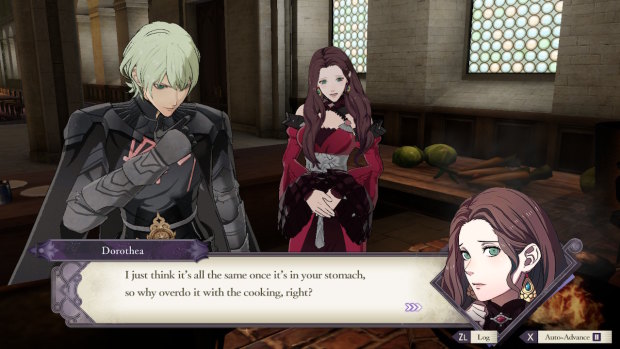
Cooking will increase your bond with one character, while delivering a week-long stat boost for everyone.
Though you can't pair your units up and make them get married this time, the protagonist can achieve an "S" rank with a character of your choosing which in most cases means they'll fall in love. But while the courting process on and off the battlefield can be a lot of fun it also remains — as in previous games — problematic.
Aspects like being able to ogle your tea party partner if you ask all the right questions or the very tropey justifications for having young-looking potential romantic partners are creepy. Meanwhile options for same-sex coupling are botched, asking a lot more of the player and being more ambiguous and limited in nature than the straight options (which boil down to just paying a lot of attention to any character of the opposite sex you like). If you want to romance any of the pretty boys in the game for example you'll want to play as the female protagonist, which is understandable given the complexity of the systems but disappointing given that the whole game's about shaping your own experience.
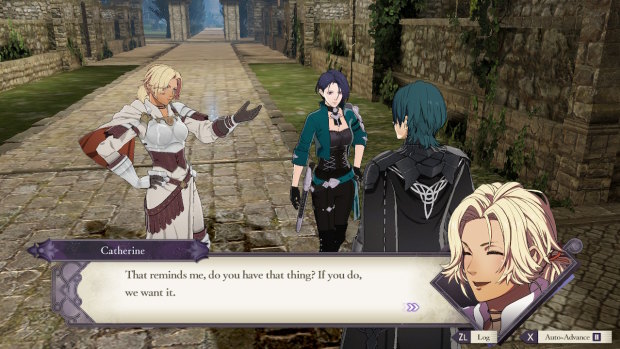
Most quests are simply a case of talking to people and finding objects, but there's plenty else to do around the monastery.
Overall the most impressive thing about Three Houses, and the reason I haven't been able to stop playing it even after more than five dozen hours, is how every one of the various systems work together to keep you moving forward. Fighting levels you up and hones skills, teaching focuses that progress towards specific class goals, and it all builds character and narrative progression, not to mention the fact that both the tactical battling and dramatic conversations are both engrossing and well designed.
There's so much in between, from the economy of weapons and items to the advanced skill of moving between classes to create mash-up styles, and even less exciting side activities like fishing and solving dilemmas for your students rewards you by increasing your Professor Level, which makes you better at everything from forging new weapons to growing plants in the greenhouse.
It might have some hang-ups, but this is a masterpiece of a strategy game and a brilliant relationship sim, which feels like the pinnacle of the love/tactics hybrid innovated by 2012's Awakening. At the end of my first run I hated the idea of starting again with a different house because of the erasure of all my favourite characters that would entail, but a game like this is just too good to walk away from.
Fire Emblem Three Houses is out now on Switch.